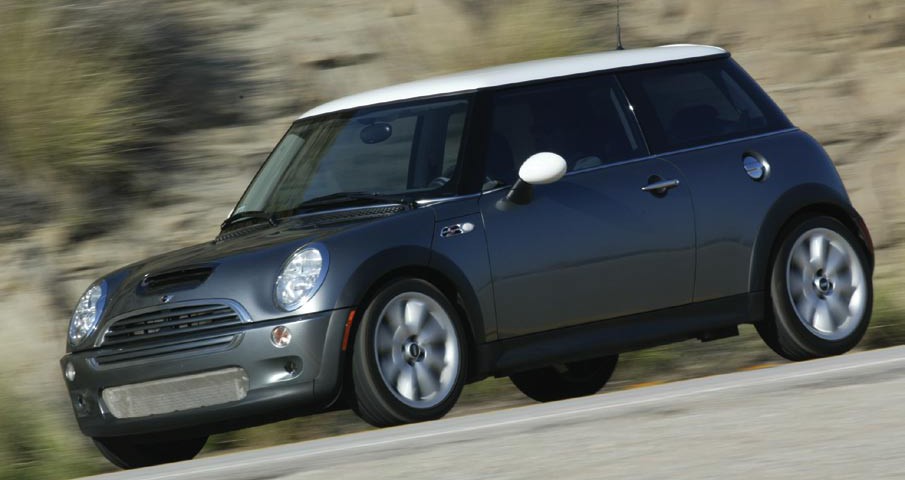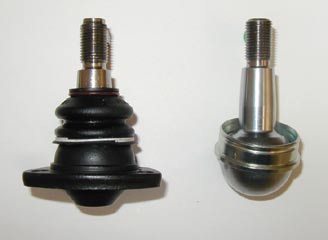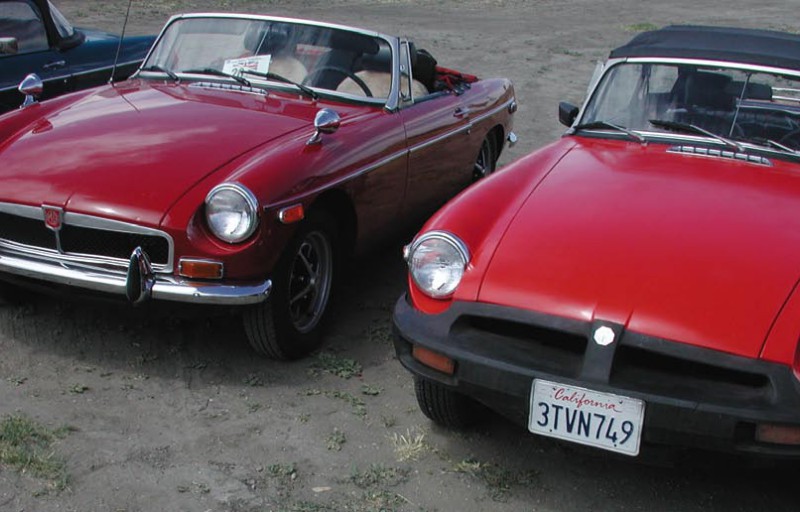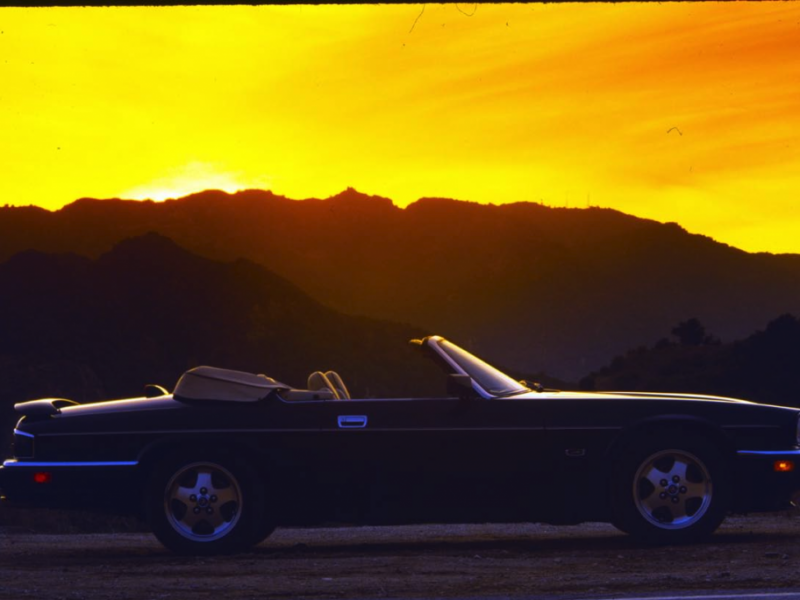Has BMW bred the Britishness out of the new cutemobile?
By Robert Goldman
Photos By Bill Delaney
While the recently deceased “classic” Beetle may forever hold the position of subcompact sales champion, one could argue that the classic Mini was a car of greater historical importance. Don’t believe me? Go out and purchase a new rear-engine, rear-drive, two-door/four-seat car. Not many choices, are there? Even the new Beetle has a transverse front-drive layout, a concept pioneered in the Mini.
Every small two-door, wheels-on-the-corners, two-box economy car on the planet today owes something to Alec Isigonis’ inspired design. When BMW took over creation of the new Mini, there was no need to change paradigms. What worked in 1959 still works today.
The remarkable aspect of the Mini concept is how an intentionally utilitarian design has become synonymous with sportscar performance. Today’s Mini, a very practical and efficient machine, is marketed in sporty and sportier forms. The Cooper S, in today’s supercharged format, is squarely targeted at enthusiasts. While there may not be another Coupe des Alpes in its future, the new S is a highly competent backroads performer.
We must have become a lot larger in the last 40 years. The new Mini looks quite small. In fact, it’s one of the smallest cars you can buy, but it looks downright big next to an original Mini. In either case, the rear seat is best suited to slim teenagers. Talk to any British adult today, and they’ll likely have stories of teenage adventures involving four or more kids and a Mini. This points to one of the fundamental differences between the old and new iterations.
The original Mini was first and foremost an economy car, intended to carry the greatest possible load in the least space, and do so without consuming much in the way of natural resources. As originally conceived, the Mini was a pretty uninspired machine. It took the vision of hardcore performance-seekers like John Cooper to identify the mighty mouse in the mundane Mini. The feature set—and consequent price tag on a new Mini—are targeted at, shall we say, a more gainfully employed clientele. Whomever the target customer, the question remains: Is the new Mini a faithful rendering in updated form or merely a new car borrowing an old name?
Styling
When parked side by side, the new car dwarfs the old. Yes, Minis really were that small. The new car may be reminiscent of the old, but in this author’s opinion, it’s a bit of a stretch to say they look much alike. Certainly, the new car’s grille is an update of the old, and it does have fender flares. Beyond that, there are fundamental differences. The original Mini had a straight-through waistline.
The new car’s rises from front to back, giving the total package a somewhat more aerodynamic look. By comparison, the old car really is just a big square box, with a small box stuck on the front.
How one can look at a box and call it cute is beyond me. It is for this reason that automotive stylists are gainfully employed. Old Mini is cute. Amazingly, the new Mini is cute in the same way—when compared with its modern contemporaries. Take the old car away and the new one looks like two boxes grafted together in the same charming fashion.
Performance Shootout
In the realm of performance, those who believe a vintage car may be fairly compared to a modern machine have not been paying attention. However, for fun we took a beautiful Australian-issue 1967 Mini Cooper S, belonging to David Rentfrow, and a new supercharged Cooper S out to Camarillo Airport for a little magazine-style testing. In fact, we snuck in a few runs in conjunction with Popular Mechanics’ 2004 fullsize pickup test. Using all the charm we could muster, we convinced them to let us record a couple numbers between runs. I never saw the truck results, but it wouldn’t surprise me if they were faster in a straight line.
With enough modification, I’m sure an old Mini could be made to accelerate faster than a new Cooper S. The new Cooper is sporty, but nothing to write home about. Safety technology adds a significant weight penalty, and the blown 1.6L single-cam motor provides adequate—if not overwhelming—power. In many respects this makes the car true to its heritage. Small British cars always placed a premium on handling and braking. Once the truck-testers suggested we turn off the traction control, it at least proved possible to smoke the 17” run-flats through First gear. This is great fun, especially if you don’t have to pay for the tires.
While the original Cooper’s 13.28-seconds 0-60 time was comparatively slow, it sounded like a million miles per hour.
Our truck-tester friends thought it was quick, just from the noise. Braking tests (60-0) were little more than a formality. The new Cooper is after all a BMW design, and its four-wheel discs with ABS produced easily repeatable results. The procedure? Stomp both brake and clutch pedals together, then let the computer do the rest. Not much drama here. After three successive stops, braking effectiveness was unchanged: 126.7’, 127.5’, and 128.5’.
The little old Cooper that could perhaps couldn’t by its third attempt. David never quite came to a stop, and drove in with smoke billowing off the discs. The truck guys, perhaps unused to seeing so much smoke without call for a fire extinguisher, firmly instructed the car not be allowed to sit until it had been driven to allow the front rotors to cool off. (The first run was a trial, and the second stopped in 156.0’ feet from 60 mph.)
With the slalom test remaining, the new Cooper was withdrawn. This led to some great speculation. Was the car withdrawn because, knowing in a test where acceleration and braking do not play a part, the classic car may have won? Wide modern tires and computer-aided suspension design would give the new car a theoretical advantage, but the much wider modern car would have had to move further side to side. Alas, we shall never know, but if you have ever seen a well-prepared classic Mini on track, one could easily speculate the new car got scared and ran away. In reality, driver David Rentfrow’s main slalom challenge in the old Mini was in not sliding off the old bench seat while whipping through the cones. And an ultimate testament to the new Mini’s handling prowess is that it’s currently Road & Track’s reigning slalom champ.
Sterile performance numbers alone have never been the true measure of car. Is it fun to drive? Does it respond as expected, or are there hidden vices waiting to trap the unwary? In this admittedly subjective realm, we shall have to call it a dead heat. Only once have I ever tried to keep pace with a modern sportscar while driving a classic. Worrying over the pace of the new car is pointless. Where old cars have the advantage is in the rewards for getting it right.
Handling
A few years ago I had the chance to drive a classic Mini in the Alps. Charging up or down a series of switchbacks in an old car is more an exercise in technique than sheer speed. One could spend an hour at a time shifting from second to third. Then braking hard and pulling a perfect heal and toe downshift back to second. So what if the car won’t run when it’s cold and the motor sounds like a mangled sewing machine? The work is immensely satisfying, and even if the brakes give out entirely, you’re not traveling fast enough to get hurt. Even on the downhill stretches an emergency downshift will provide enough revs and compression breaking to save the car.
While I haven’t driven a new Cooper in the Alps, there are a few short stretches in the coastal mountains of Southern California in which one can duplicate the experience. It becomes plainly obvious; the levels of grip and power place this new car in a different realm. In spite of its superb brakes and brain-fade-saving traction control, the new Mini will bite back when pushed too far. While I have never feared building enough speed in an old Mini to slide off a cliff, the new car can generate serious momentum.
Are the new and old Minis fun to drive? Absolutely. Do they equally love tight, twisting mountain roads? In a word, yes. Is one better than the other? A loaded question indeed. I’ll say this much: The new Mini can be worked so hard through the hills that this driver has made himself car sick while driving. However, unlike a dog that will eat himself sick at any opportunity, with a little discretion the drivers of Minis new or old will have all the fun they can handle.










'New Mini vs. Classic Cooper S' has no comments
Be the first to comment this post!